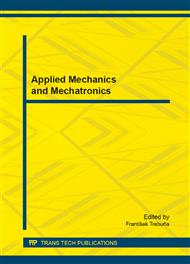[1]
Emsyst: Shear-web Load Cell EMS30. Avalibe: http: /emsyst. sk/images/snimace_sily/standartne/EMS30a. pdf.
Google Scholar
[2]
Interlink Electronics: FSR Force Sensing Resistor Integration Guide and Evalution Parts Catalog. Available: http: /www. imagesco. com/sensors/fsr/fsrguide. pdf.
Google Scholar
[3]
A. Erwin et al.: Interaction Control For Rehabilitation Robotics via a Low-Cost Force Sensing Handle, in: DSCC2013 Proceedings of the ASME 2013 Dynamic Systems and Control Conference (2013).
Google Scholar
[4]
F. Trebuňa and P. Sivák: Experimentálne metódy mechaniky: Tenzometria, TU Košice (2012). ISBN 978-80-553-1378-8.
Google Scholar
[5]
A. Hošovský et al.: Model-based Evolution of a Fast Hybrid Fuzzy Adaptive Controller for a Pneumatic Muscle Actuator, in: International Journal of Advanced Robotic Systems. Vol. 9 (56) (2012), pp.1-11. – ISSN 1729-8806.
DOI: 10.5772/50347
Google Scholar
[6]
I. Mack et al.: Interactive Force Sensing Feedback System for Remote Robotic Laparoscopic Surgery, in: Haptic Audio visual Environments and Games. (2009) Available: http: /ieeexplore. ieee. org/stamp/stamp. jsp?tp=&arnumber=5356129.
DOI: 10.1109/have.2009.5356129
Google Scholar
[7]
T. Kelemenová et al.: Model based design and HIL simulations, in: American Journal of Mechanical Engineering. Vol. 1 (2013), pp.276-28. ISSN 2328-4102.
Google Scholar
[8]
K. Židek and A. Hošovský: Wireless Device Based on MEMS Sensors and Bluetooth Low Energy (LESmart) Technology for Diagnostics of Mechatronic Systems, in: Applied Mechanics and Materials. Vol. 460 (2014), pp.13-21. ISSN 1660-9336.
DOI: 10.4028/www.scientific.net/amm.460.13
Google Scholar
[9]
P. Berkelman et al.: A Miniature Microsurgical Instrument Tip Force Sensor for Enhanced Force Feedback During Robot-Assisted Manipulation, in: IEEE Transactions On Robotics And Automation. (2003).
DOI: 10.1109/tra.2003.817526
Google Scholar
[10]
M. Tóthová and J. Piteľ: Dynamic model of pneumatic actuator based on advanced geometric muscle model, in ICCC 2013: IEEE 9th International Conference on Computational Cybernetics, IEEE (2013), pp.83-87. ISBN 978-1-4799-0060-2.
DOI: 10.1109/icccyb.2013.6617566
Google Scholar
[11]
M. Dalvand et al.: Force Measurement Capability for Robotic Assisted Minimally Invasive Surgery Systems, in: Proceedings of the World Congress on Engineering and Computer Science 2013. (2013).
Google Scholar


